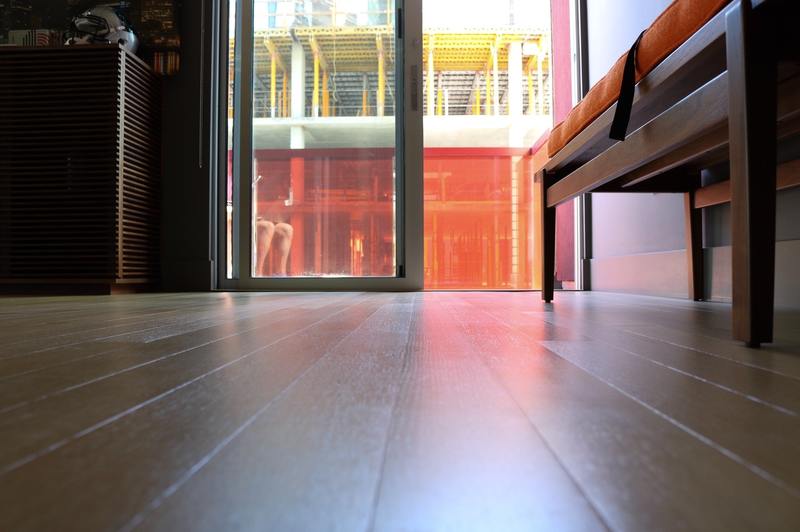Nail the boards or replace them one by one; these are the best ways on how to flatten water damaged floor. It depends on your floor type and the extent of the water damage.
Wooden floors usually buckle or swell when they are oversaturated with water, so try to check your floor material. Hardwood floors can just be nailed back into place, while laminated wood will have to be replaced entirely.

Signs Of Water Damage
Several home issues cause water damage, like leaking pipes, appliances, lousy weather, and floods. You must look out for signs of water damage before it gets too severe.
Hardwood floors
These floors are made from pure wood, and it usually comes from Oak or Hickory trees. It’s a popular choice for flooring because it’s durable and it can carry heavy weight.
Sadly, hardwood isn’t susceptible to water damage. It may show wear and tear when it’s soaked for too long.
You’ll there’s water damage if you see:
- Dark spots – These spots are a sign of mold from excessive moisture.
- Bulging – This damage happens when the floorboards swell upwards.
- Cupping – You will see your floor has uneven edges.
- Buckling – This damage is when the planks are entirely removed from the subfloor.
Laminate floors
These floors are made of different wood types stuck together. Laminate floors are also excellent for homes because they are scratch-resistant, easy to clean, and affordable.
The downside of this material is that it’s susceptible to water damage, so it’s not ideal for bathrooms and kitchens. Even in the safer home areas, your laminate floors could get too much moisture. Look out for the signs of water damage in laminate floors.
- Warping – When planks are wet, they bulge or “cup.”
- Discoloration – Dark spots could mean mold or mildew in your planks.
- Swelling – This damage usually occurs on the plank edges.
Step-By-Step Process On How To Repair Water Damaged Floor
After you spot the damage, it’s time to fix your bulging floors. Hardwood and laminate wood have different approaches for repair.
Method #1. Flattening hardwood floors
Hardwood is more robust, so it may only need a minor fix.
Step #1. Fix the small warped areas
You can nail or screw the bulging planks flat on the floor again.
Step #2. Remove severely damaged areas
Some parts may have more considerable damage, so you should replace those areas. Cut out the moldy parts with a saw and remove them with a ply bar. Replace the planks with something similar to the floor you have.
Step #3. Sand the boards
Sanding will make your planks look even, and now your floor is back to normal!
Method #2. Flattening laminate wood floors
Laminate floors can absorb more moisture, so you will need more extensive repairs.
Step #1. Dry the floor
Use a dehumidifier or some fans; your floor will bulge soon after.
Step #2. Remove damaged boards
Start from the planks near the wall and work inward. Remove all the planks that have visible damage, or maybe even the whole floor if necessary.
Step #3. Replace the damaged planks
You can reuse some of the planks that are still in good condition. Make sure the subfloor is also completely dry before putting the new planks.
Should You Also Repair The Subfloor?
The subfloor is the part under your main floor, and it’s usually made of plywood or concrete. Sometimes this damaged part is what makes your planks rise and swell with moisture, and it may feel mushy when you step on it.
It’s essential to repair the subfloor before you replace the main planks. You can remove the damaged parts of the floor using a circular saw, then apply the new plywood. This layer is the foundation of your flooring, so it must be in excellent condition to prevent the planks from bulging.
How To Prevent Swelling In Wooden Floors
Flattening floor repairs can be costly, especially when the damage is severe. That’s why you need to protect your planks from water damage to save costs.
Place rugs on the floor
Rugs can protect your planks from little sprinkles and leaks. It’s best to do this around water-dependent appliances like dishwashers, washing machines, and refrigerators.
Make the boards water-resistant
Use products like a coating or wax to protect your flooring. You can apply coating or sealant to the boards before they are installed; remember to re-apply the chemical every 12 months.
You can also apply wax to the floor, which you must spread evenly. Just make sure there isn’t any urethane on your planks as they could become too slippery. This substance must also be applied every 12 months.
Will Home Insurance Cover Floor Buckling?
If the water damage to your floor is severe, you may have to replace the whole thing. That’s going to be a high cost for repairs.
So, maybe your homeowner’s insurance can help out a little? Will it cover the damages and repair expenses?
Well, that depends on the circumstances of the water damage. Most insurance coverage includes damages from leaks and faulty appliances; it may even cover sewage overflow if you’re lucky.
Flooding due to weather is another issue, though. Most people need to get separate flood insurance to cover these concerns. Just remember to compromise with your agent and ask your lawyer’s help if you have questions.
Conclusion
Swelling and buckling are sure signs of excess moisture in your floors. You can put your boards back to normal when you know how to flatten water damaged floor. Your house will be clean and dry again!
